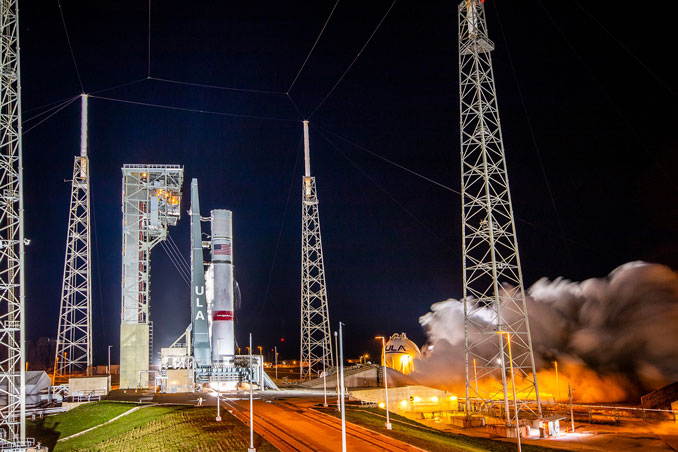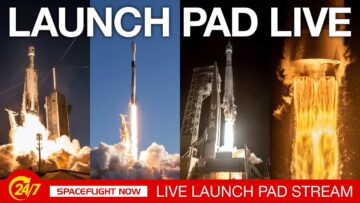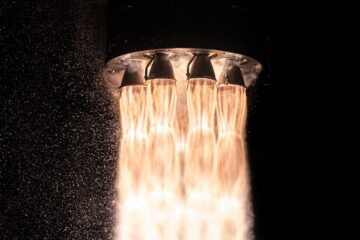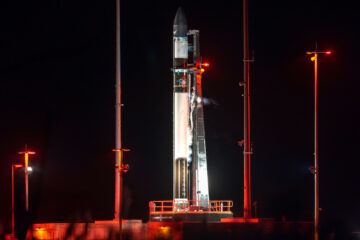
The debut of United Launch Alliance’s next generation rocket, the Vulcan Centaur, is now scheduled for the fourth quarter of 2023, following an investigation into a mishap that destroyed an upper-stage test article, company CEO and President Tory Bruno said during a media briefing on Thursday.
ULA had hoped to launch the two-stage rocket on its inaugural mission, dubbed Certification-1 or Cert-1, this summer. However, extra adjustments needed on the Vulcan first stage, as well as an ongoing investigation into a hydrogen leak that caused an explosive blast during certification testing of the rocket’s Centaur 5 upper stage delayed that.
Providing a detailed description of both the investigation and corrective actions needed in response to the leak, Bruno said “it is quite possible that the Cert-1 [Centaur 5] vehicle that we had on top of the booster when we did the flight readiness firing could fly successfully” since it hadn’t been exposed to the same types of rigors and stressors as was the case with the test article that experienced the anomaly.
He said however, they concluded that wasn’t the best route.
“So yeah, it’s quite possible we could’ve flown, but Cert-1 has real payloads on it and ‘quite possible’ isn’t really good enough,” Bruno said. “I think other people might’ve thought seriously about flying that vehicle in the condition it was, but we’re not other people.”
“And so, we’re going to take the time and apply the corrective actions so that we know this won’t be an issue in that flight.”
Outside of the test rig/ stand. Test article is inside (you can’t see it). Hydrogen leak. H2 accumulated inside the rig. Found an ignition source. Burned fast. Over pressure caved in our forward dome and damaged the rig. pic.twitter.com/0d0KpI1ggj
— Tory Bruno (@torybruno) April 13, 2023
What went wrong?
Bruno said the leak that prompted the months-long investigation into its Centaur 5 test article came around halfway through its 15th test at a testing facility at NASA’s Marshall Space Flight Center in Huntsville, Alabama, down I-565 from ULA’s factory in Decatur.
He noted that 15 tests is about a third of the number needed to qualify the full range of flights that Vulcan could be asked to perform on future missions.
“Different trajectories stress different parts of this structure uniquely,” Bruno explained. “And so, in order to qualify the entire fleet, or you might think of it as a universe of possible trajectories, you have to test them almost separately. And we were through 14 [with] successful ends.”
The hydrogen tank in the Centaur 5 upper stage is about 40-feet-long and has an 18-feet diameter and is built from stainless steel that Bruno described as “thinner than a dime” or thicker than a high-quality wedding invitation.
It sits atop the liquid oxygen cryogenic tank. Both are wrapped up in a long cylinder and are separated by an intermediate bulkhead.
Bruno said the leak, which lasted for about 4.5 minutes before the rupture occurred, was on the forward dome of the hydrogen tank. The dome consists of a series of curved triangles with a door at the top which provides access to the tank. He said it’s similar to the design of the Centaur 3, used on the Atlas 5, but notably larger.
During the investigation, they determined that a weld near the door experienced a greater load than it could handle, due to its geometry, thus leading in part to the leak.
“That particular phenomenon was not present on Centaur 3 because of its smaller scale and slightly different geometry,” Bruno said. “However, if that’s all that had been present, it would not have failed.”
Bruno said the other contributing factor was determined to be the type of weld that was used. For the Centaur 3, ULA used an arc weld compared to a laser weld for the Centaur 5. He said that “the as-built strength of these laser welds is less than we had assessed when we did coupon testing,” which is a method of evaluating materials.
“The two things together, higher loads, somewhat lower strength in the welds are what caused the crack to begin,” Bruno said.
He also pointed back to the fact that this test article had performed 14 prior tests, “which is considerably more testing and exposure to loads and many more pressure cycles and lots and lots of more time of the structure sitting under pressure than would ever happen in any single flight.”
What’s ULA’s solution?
Bruno said essentially, they will reinforce the design of the dome, which should rectify the issue. They will be adding about 300 pounds of reinforcements to the dome of the Centaur 5 that will fly as part of the Cert-1 mission.
That includes what Bruno describes as a “ring doubler, 15 stripped doublers” as well as removing the milling process that previously reduced part of the dome’s surface to 26 thousandths of an inch.
In comparison to the rest of the Vulcan Centaur rocket, the addition 300 pounds represents about 0.25 percent of the vehicle’s weight. Bruno said following the first rocket’s alteration, “the ones right after it will be about 150 pounds heavier.”
The proposed fix is currently being implemented on the third Centaur 5, which Bruno said should be finished soon. It will be traded for the Centaur 5 that was stacked with the Vulcan booster during last month’s Flight Readiness Firing test.
The second Centaur 5, which was intended to be flown the the Cert-2 mission, will instead be converted to a test asset and used to qualify the Cert-1 mission trajectory. Bruno said that sets them up to fly the Cert-1 mission during the fourth quarter of 2023.
The fourth Centaur 5 will also be used to replace the test article that was severely damaged in the hydrogen leak incident. That will allow them to complete qualification for the rest of the Vulcan fleet by the first quarter of 2024.
“And then, from that point forward, we’re done with this because that’s the last thing we need to do to qualify the vehicle,” Bruno said. “So, that’s the whole path.”
BE-4 engine failure not a concern
Thursday’s briefing also came days after news broke that one of Blue Origin’s BE-4 engines exploded during an acceptance test last month. Two BE-4 engines power the Vulcan booster on each rocket.
The engine that exploded was intended to be delivered for the Cert-2 flight of Vulcan, supporting the inaugural launch of Sierra Space’s Dream Chaser cargo spacecraft.
Bruno said the engine in question failed its first acceptance test and was in the middle of its second acceptance test procedure (ATP) when it “crossed the threshold” of acceptance and the computer attempted to shut it down.
He said the threshold was too high and the computer wasn’t able to shut the engine down before it “had a burn through.”
When asked if the issue gave ULA concern about the engines on the Vulcan booster that will fly the Cert-1 mission, Bruno said no, since they examined to see if the issue from the failed engine existed on the others and it didn’t, nor did it “indict the qualification at all.”
“We were very confident in the design and the workmanship of the assets that have passed acceptance. This is not unexpected. It won’t be the last. And there will be other components on the rockets that also fail acceptance testing,” Bruno said.
“And, you know, I’m flattered by the attention we have now, that a routine acceptance test was colorfully discussed on social media, but it really isn’t news.”
What comes next?
In addition to the work being done by ULA, the next steps include the arrival of the flight payloads from Amazon and Astrobotic. Currently the Peregrine lunar lander is on display inside Astrobotic’s clean room, which is visible to guests of the adjacent Moonshot Museum in Pittsburgh.
Spaceflight Now reached out to Astrobotic to see when it expects to ship its lander, but did not hear back before publishing.
Bruno said ULA is currently working with Astrobotic to determine when they would be able to launch the Cert-1 mission. Because it’s heading to the Moon, there are only a handful of days in which they can launch to land in the desired conditions.
Following that mission, Bruno said they expect to launch the Cert-2 mission a few months later before flying the first national security space launch (NSSL) mission a few months after that in the second quarter of 2024. That mission is likely to be the NROL-106 mission, but Bruno said it’s too far out to be able to confirm the name or details of that mission.
- SEO Powered Content & PR Distribution. Get Amplified Today.
- PlatoData.Network Vertical Generative Ai. Empower Yourself. Access Here.
- PlatoAiStream. Web3 Intelligence. Knowledge Amplified. Access Here.
- PlatoESG. Automotive / EVs, Carbon, CleanTech, Energy, Environment, Solar, Waste Management. Access Here.
- BlockOffsets. Modernizing Environmental Offset Ownership. Access Here.
- Source: https://spaceflightnow.com/2023/07/13/ula-outlines-path-to-inaugural-vulcan-launch-following-upper-stage-issues/
- :has
- :is
- :not
- $UP
- 13
- 14
- 15%
- 2023
- 2024
- 25
- 26
- 300
- 7
- a
- Able
- About
- acceptance
- access
- Accumulated
- actions
- adding
- addition
- adjacent
- adjustments
- After
- Alabama
- All
- allow
- also
- Amazon
- an
- and
- any
- Apply
- Arc
- ARE
- around
- arrival
- article
- AS
- asked
- assessed
- asset
- Assets
- At
- atlas
- attempted
- attention
- back
- BE
- because
- been
- before
- begin
- being
- BEST
- Blue
- blue origin
- booster
- both
- Briefing
- Broke
- Bruno
- built
- burn
- burned
- but
- by
- came
- CAN
- Cargo
- case
- caused
- Center
- ceo
- Certification
- comes
- company
- compared
- comparison
- complete
- components
- computer
- Concern
- concluded
- condition
- conditions
- confident
- Confirm
- considerably
- consists
- contributing
- converted
- could
- coupon
- crack
- cryogenic
- Currently
- cycles
- Days
- debut
- Delayed
- delivered
- described
- description
- Design
- desired
- destroyed
- detailed
- details
- Determine
- determined
- DID
- different
- discussed
- Display
- do
- done
- Door
- down
- dream
- dubbed
- due
- during
- each
- ends
- Engine
- Engines
- enough
- Entire
- essentially
- evaluating
- EVER
- existed
- expect
- expects
- experienced
- explained
- exposed
- Exposure
- extra
- Facility
- fact
- factor
- factory
- FAIL
- Failed
- Failure
- far
- FAST
- few
- firing
- First
- Fix
- FLEET
- flight
- Flights
- flying
- following
- For
- Force
- Forward
- found
- Fourth
- from
- full
- future
- gave
- generation
- geometry
- going
- good
- greater
- guests
- had
- halfway
- handful
- handle
- happen
- Have
- he
- Heading
- hear
- High
- high-quality
- higher
- However
- http
- HTTPS
- hydrogen
- if
- Ignition
- image
- implemented
- in
- Inaugural
- incident
- include
- includes
- inside
- instead
- intended
- Intermediate
- into
- investigation
- invitation
- issue
- issues
- IT
- ITS
- jpg
- june
- Know
- Land
- larger
- laser
- Last
- later
- launch
- leading
- leak
- less
- likely
- Liquid
- load
- loads
- Long
- lower
- Lunar
- lunar lander
- many
- materials
- max-width
- Media
- method
- Middle
- might
- minutes
- Mission
- missions
- Month
- months
- Moon
- MoonShot
- more
- Museum
- name
- National
- national security
- Near
- Need
- needed
- news
- next
- no
- nor
- notably
- noted
- now
- number
- occurred
- of
- on
- ONE
- ones
- ongoing
- only
- or
- order
- Origin
- Other
- Others
- our
- out
- outlines
- over
- Oxygen
- part
- particular
- parts
- passed
- path
- People
- percent
- perform
- performed
- phenomenon
- pittsburgh
- plato
- Plato Data Intelligence
- PlatoData
- Point
- possible
- pounds
- power
- present
- president
- pressure
- previously
- Prior
- procedure
- process
- proposed
- provides
- Publishing
- qualification
- qualify
- Quarter
- question
- range
- reached
- Readiness
- real
- really
- Reduced
- reinforce
- removing
- replace
- represents
- response
- REST
- rig
- right
- rocket
- Room
- Route
- Said
- same
- Scale
- scheduled
- Second
- second quarter
- security
- see
- separately
- Series
- seriously
- Sets
- severely
- should
- similar
- since
- single
- sits
- Sitting
- slightly different
- smaller
- So
- Social
- social media
- solution
- somewhat
- Soon
- Source
- Space
- Space Force
- spacecraft
- stacked
- Stage
- Stainless Steel
- stand
- station
- steel
- Steps
- strength
- stress
- structure
- successful
- Successfully
- summer
- Supporting
- Surface
- Take
- tank
- test
- Testing
- tests
- than
- that
- The
- Them
- then
- There.
- These
- they
- thing
- things
- Think
- Third
- this
- thought
- threshold
- Through
- thursday
- time
- to
- together
- too
- top
- traded
- trajectory
- true
- two
- type
- types
- under
- Unexpected
- uniquely
- United
- Universe
- used
- vehicle
- very
- visible
- vulcan
- was
- we
- wedding
- weight
- WELL
- went
- were
- What
- when
- which
- whole
- will
- with
- Work
- working
- would
- Wrapped
- Wrong
- you
- zephyrnet




